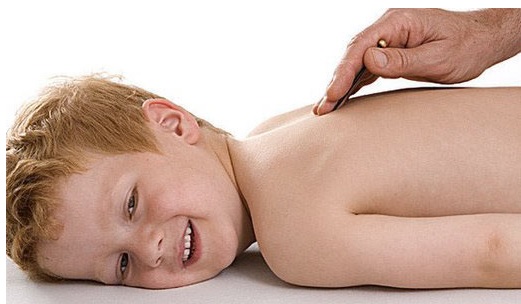
As the kids head back to school and things begin to shift, accidents can happen and problems can arise. Somebody breaks a bone, sleep becomes more difficult, digestion gets off, kids feel anxious and the list goes on and on. Most kids, as well as a lot of adults, are afraid of needles. So the pairing of acupuncture and kids might not be an obvious one. However, more and more parents are seeking alternative methods of treatment for their children. This is because our conventional medical system is faltering a bit. Pharmaceuticals are proving to be more harmful than beneficial for many, especially kids. And with the bodies and brains of children still being developed, who can really blame a parent for wanting to find an alternative to drugs with adverse side effects?
Pediatric acupuncture is commonly known as shonishin and it rarely uses needles. Instead this form of acupuncture utilizes the practitioners’ hands and rounded tools to stimulate the acupoints on the body of the child. The practitioner will gently and rhythmically stroke, rub, tap and press the skin to produce gentle stimulation sensations. Because children process things more quickly and with fewer blockages, the shonishin sessions can be shorter and may be needed less frequently.
Parents are turning to acupuncture because it provides a safe resolution of illness and injuries, while also preventing future issues. This happens because acupuncture and acupressure stimulate the body’s ability to restore and heal itself. Our bodies are fully capable of fighting off disease and healing injuries when the right tools are provided. Acupuncture is that right tool that not only stimulates the immune system, but also relaxes the nervous system and regulates the digestive and hormonal systems. All of these things need to be in balance for the body to heal.
Another reason why this medicine can be so much more effective is the fact that acupuncture treats the person holistically. Many times parents are told by doctors that what their child is experiencing is just “a phase” and he / she “will grow out of it”. In many ways, this is a way of ignoring the real issues at hand. Conventional medicine doesn’t work holistically and parents are usually sent to a dozen different specialists who never really coordinate to find the best treatment for the child. This becomes frustrating and financially taxing for the parent, not to mention how the child feels. This is where acupuncture excels. A single acupuncture treatment can address pain, anxiety, insomnia and digestive issues all at the same time.
Not only is acupuncture more cost effective when it comes to treating children, but it also is a more logical approach. Why add in the stress of seeing multiple doctors when you can have everything addressed by just one? But there are also things you as a parent can do that incorporate the shonishin techniques, which can help your child in the comfort of his own room. Here are some acupressure points that can be used at home to help your kids with all kinds of problems.
Large Intestine 4 (LI 4) is found along the large intestine energetic pathway. It is located between the webbing of the index finger and the thumb, on the mound of flesh that is created when the two fingers are held together. This point improves intestinal function and helps relieve constipation, diarrhea and abdominal pain. Digestive issues tend to be common in kids and this point is a big gun in helping correct these problems. LI4 is also a great pain relief point that can help with pain anywhere in the body.
Stomach 36 (ST36) is located on the lateral side of the lower leg, about 4 finger-breadths from the lower border of the patella or kneecap. This point is considered an overall energy and immune-boosting point. It can help with digestive issues, such as diarrhea, that are sometimes associated with a cold or the flu. And it is also a great point for bolstering the immune system.
Yin Tang is located directly between the inner ends of the eyebrows. This point is wonderful for relieving sinus pressure, helping with watery eyes and decreasing stress, which may allow for better sleep. Many acupuncturists use the point in their patients because of its calming effect. So if you have a little one that can’t sleep, massaging this point can be very helpful.
Du 20 (D20) is located on the top of the head, midway between the apexes of your ears. This point is known as governing vessel 20 (GV 20). It is one of the most powerful points in the acupuncturists’ arsenal. It raises emotional energy, which in turn can help alleviate depression. Applying pressure or lightly tapping this point is a great way to counter depression on your own and it can be done pretty much anywhere. Depression is becoming more prevalent with children because of the lack of personal interaction and bullying.
Stomach 25 (ST 25) is located two thumb-breadths away from the belly button on both the left and right sides. Stomach 25 is very useful for relieving diarrhea, constipation and other digestive / abdominal issues. This is another great pressure point to help your kids deal with that upset stomach.
If your child is suffering from pain or some other ailment, shonishin acupuncture might hold the key to their relief. To find out more, contact us. If we are unable to help, we will get you connected with somebody who can.

